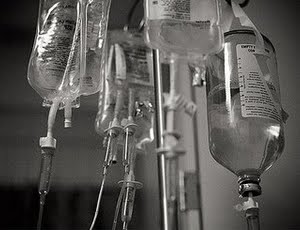

WHY NOT PALLIATIVE ONCOLOGY?
The goal of palliative care is to relieve symptoms, reduce suffering and improve a patient’s quality of life. In palliative oncology chemotherapy and radiation are used, not for a logarithmic cell kill, but to resolve specific problems caused by the cancer. Thus the focus of palliative oncology differs from its more aggressive traditional role. Here intent is the key difference; “curing” versus “healing”. Until recently the primary objectives of oncology had been summated in the following adage.
“Foremost to cure,
If no cure then to control,
If no control then to palliate”
With the advent of hospice and palliative care, palliative oncology should no longer be an issue of giving more and more pain medication. Chemotherapy and radiation can be administered, albeit at lower dosages and shorter schedules, for the purpose of reducing or eliminating symptomatic tumors. In short, palliative oncology can reduce the symptoms, suffering and pain medication requirement by controlling the cancer.
The primary targets of palliative oncology are these symptoms categorized below.
Compression; of nerves, vessels and lymphatics which can lead to neuropathies and limb edema / thrombosis. The application of radiation focally or chemotherapy for multiple-site effects can decrease pain and swelling. An example of this would be the administration of 30 Gy / 10 fractions in the treatment of spinal cord compression or carcinomatous plexopathy.
Hemorrhage; as with a cancerous skin wound can have radiation applied for as little as 250-800 cGy per fraction daily. This can stop weeping in a few days. It can also sclerose most bleeding vessels though its efficacy decreases as the target vessel becomes larger.
Obstruction; as with a hollow viscus chemoradiotherapy can be given to reduce tumor obstruction, thereby allowing a stent placement and hopefully obviating the need for a diverting ostomy.
Pain; and by this I mean intractability to medical management. Under circumstances where a growing cancer is causing increased pain it may only be a stopgap measure to increase a patient’s morphine or methadone, or to add adjuvant medications. With as little as 800 cGy / 1 fraction, for example, pain relief can be achieved and the radiation can be repeated later if necessary.
In the setting of metastatic ‘solid’ tumors palliation is always the main course with quality of life as the primary goal. For metastatic cancer the consensus of a European expert panel determined that the goals of (palliative) chemotherapy are to obtain maximum control of symptoms, prevent serious complications and increase survival without diminishing quality of life. (1) Palliative treatment should control disease in at least 20-30% of patients with an acceptable side-effect profile. The patient’s quality of life also seemed to fare better when personal issues were considered such as oral (versus intravenous) therapy, home (versus clinic / hospital) treatment and regimens designed so as to prevent or at least decrease the risk of hospitalization. Furthermore, the overall costs of home-based and oral-based chemotherapy are less than their traditional counterparts.
In the metastatic setting when a ‘cure’ is no longer obtainable the patient’s involvement in their quality of care becomes just as important. When offered second-line chemotherapy for advanced breast cancer patients were more likely to proceed with treatment due to the HOPE that the chemotherapy offered and, additionally, were most likely to take an active role in their treatment (than did women offered first-line chemo). They did so even though their expectations for a ‘cure’ were diminished. (2, 3, 4)
Palliative oncology typically involves adjusting or titrating regimens to fit the patient’s needs (eg improve the quality of life). Our standard chemotherapy regimens can be amended to provide maximal palliative effect with minimal toxicity, no matter what the patient’s status. This was recently echoed at the university level; “physicians at Moffitt have demonstrated that chronologic age poorly reflects physiologic age and that cancer treatment needs to be tailored to the individual patient”. (5)
Palliative oncology proffers a new point of view. Isn’t using chemotherapy and radiation for palliative care just as important as its use for cure? Do we dwell too much on new pain medications when we could offer our cancer patients these alternate ways to reduce their suffering?
References;
1. Crown J, Dieras V, Kaufmann M, von Minckwitz G, Kaye S, Leonard R, Marty M, Misset JL, Osterwalder B, Piccart M: Chemotherapy for metastatic breast cancer – report of a European expert panel. The Lancet Oncology. 2003;3:719-726.
2. Grunfeld E, Maher EJ, Browne S, Ward P, Young T, Vivat B, Walker G, Wilson C, Potts HW, Westcombe AM, Richards MA, Ramirez A: Advanced breast cancer patient’s perceptions of decision making for palliative chemotherapy. J Clin Oncol 2006;24(7):1090-1098.
3. Matsuyama R, Reddy S, Smith TJ: Why do patients choose chemotherapy near the end of life? A review of the perspective of those facing death from cancer. J Clin Oncol 2006;24(21):3490-3496.
4. Harrington S, Smith TJ: The role of chemotherapy at the end of life. JAMA 2008;299(22):2667-2678.
5. Extermann M. Senior adult oncology program. Moffitt Cancer Center / USF. June 2009.
by: Robert Killeen MD



